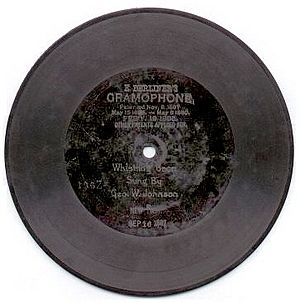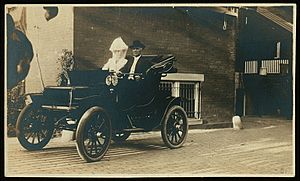Emile Berliner facts for kids
Quick facts for kids
Emile Berliner
|
|
|---|---|
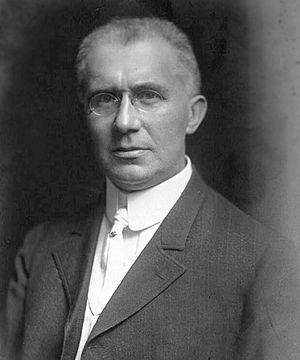
Emile Berliner
|
|
| Born | May 11, 1851 Hanover, Kingdom of Hanover, German Confederation
|
| Died | August 3, 1929 (aged 78) Washington, D.C., United States
|
| Resting place | Rock Creek Cemetery |
| Nationality | German, American |
| Alma mater | Cooper Union Institute |
| Occupation | Inventor |
| Known for | Disc record, microphone |
| Spouse(s) |
Cora Adler
(m. 1881–1929) |
| Children | 7; including Henry Berliner |
| Awards | Elliott Cresson Medal (1913) |
Emile Berliner (May 20, 1851 – August 3, 1929) was an amazing inventor. He was born in Germany and later became an American citizen. He is most famous for inventing the flat disc record, which we often call a "gramophone record." He also invented the Gramophone, a machine to play these records.
Emile Berliner started many important companies. These include the United States Gramophone Company in 1894 and The Gramophone Company in London in 1897. He also helped create Deutsche Grammophon in Germany and the Victor Talking Machine Company in 1901.
Contents
Early Life and Education
Emile Berliner was born in Hanover, Germany, in 1851. His family worked as merchants. Even though his family wanted him to be a merchant, Emile loved inventing. He worked as an accountant to earn money.
In 1870, Emile moved to the United States to avoid being drafted into the army. He first lived in Washington, D.C., and then moved to New York. There, he worked odd jobs like delivering newspapers. At night, he studied physics at the Cooper Union Institute.
Inventions and Career
After studying, Emile became very interested in new sound technology. He focused on the telephone and the phonograph. He invented a better telephone transmitter, which was one of the first types of microphones. The Bell Telephone Company bought his patent for this invention.
Emile Berliner became a United States citizen in 1881. He also invented other cool things. These included an early type of radial engine for aircraft in 1908. He also worked on a helicopter in 1919 and even created special acoustic tiles in the 1920s.
The Gramophone and Disc Records
In 1886, Berliner started working on new ways to record sound. In 1887, he received his first patent for what he called the "Gramophone." His idea was to record sound onto a flat disc. This was different from other machines that used cylinders.
Using discs made it easier to make many copies of a recording. At first, he recorded sound onto zinc discs covered with wax. Then, he used acid to etch the sound grooves into the metal.
By 1890, a company in Germany was already making toy Gramophones. They also made small, five-inch hard rubber discs. These were sold only in Europe at first. Berliner wanted his Gramophone to be more than a toy.
In 1894, he convinced some business people to invest money. With this, he started the United States Gramophone Company. He began selling seven-inch records and a larger Gramophone. These early machines still had to be cranked by hand.
Improving the Gramophone
It was hard to keep the hand-cranked Gramophone spinning at a steady speed. This made the music sound uneven. An engineer named Eldridge R. Johnson helped Berliner solve this problem. Johnson owned a machine shop and helped develop a good, low-cost spring motor for the Gramophone. This motor made the turntable spin smoothly.
The Gramophone was designed to make lasting recordings of voices and music. The records were made of strong materials like hard rubber or metal. This meant they wouldn't break easily. The sound was stored in grooves that went side to side. This was different from other machines that used grooves of different depths. The best part was that many copies of these records could be made. Each copy would sound exactly like the original.
Work on Helicopters
Berliner also worked on improving vertical flight. He developed a lightweight rotary engine between 1907 and 1926. This engine was important for helicopters.
In 1909, a newspaper reported that a helicopter built by Berliner and J. Newton Williams had lifted a person off the ground. By 1910, Berliner was experimenting with a tail rotor. This small rotor at the back helps control the helicopter. This design was very important for making practical helicopters in the 1940s.
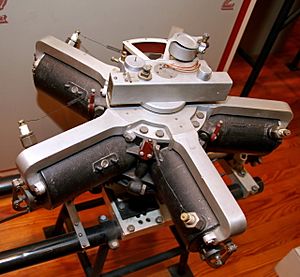
On July 16, 1922, Berliner and his son, Henry, showed a working helicopter to the United States Army. Henry later started the Berliner Aircraft Company in 1926.
Awards and Recognition
Emile Berliner received several important awards for his inventions. He was given the Franklin Institute's John Scott Medal in 1897. Later, he received the Elliott Cresson Medal in 1913 and the Franklin Medal in 1929.
Later Life and Death
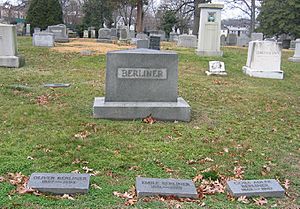
Emile Berliner passed away on August 3, 1929. He was 78 years old and died from a heart attack at his home in Washington D.C. He is buried in Rock Creek Cemetery in Washington, D.C., with his wife and one of his sons.
Images for kids
See also
 In Spanish: Emile Berliner para niños
In Spanish: Emile Berliner para niños


